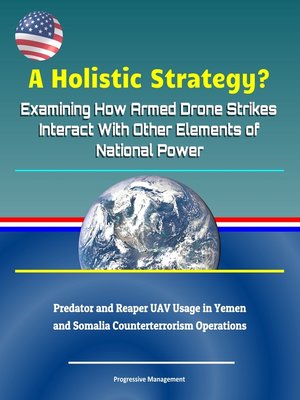A Holistic Strategy? Examining How Armed Drone Strikes Interact With Other Elements of National Power
ebook ∣ Predator and Reaper UAV Usage in Yemen and Somalia Counterterrorism Operations

Sign up to save your library
With an OverDrive account, you can save your favorite libraries for at-a-glance information about availability. Find out more about OverDrive accounts.
Find this title in Libby, the library reading app by OverDrive.



Search for a digital library with this title
Title found at these libraries:
| Loading... |
This report has been professionally converted for accurate flowing-text e-book format reproduction. Armed drones, technically known as MQ-1B Predators and MQ-9 Reapers, have become a preferred tool in U.S. counterterrorism operations. The use of armed drones in counterterrorism strategy, however, has spurred worldwide debate over the morality, legality, accountability, and effectiveness of the campaigns. Despite the concerns and debates about the armed drone programs, the armed drone campaigns will likely not only continue but also expand in the future. The purpose of this thesis is to explain how the application of armed drone strikes in fragile states has interacted with other elements of national power to achieve the objectives defined in the United States' counterterrorism strategy. The research examines what the United States conducted in fragile states in terms of diplomatic, information, military—other than drone strikes—and economic instruments of national power to achieve the objectives outlined in the United States' counterterrorism strategy. Using Yemen and Somalia as case studies, this thesis shows that armed drones do interact positively with other elements of national power, but the employment of all instruments falls short of meeting the U.S. objectives for the countries. Incidentally, the failures do not result from the use of armed drones but from a misuse in some of the other instruments of national power.
I. INTRODUCTION * A. ARMED DRONES AS A WEAPON IN COUNTERTERRORISM * B. MAJOR RESEARCH QUESTION * C. SIGNIFICANCE OF THE RESEARCH QUESTION * D. LITERATURE REVIEW * 1. Counterterrorism: Definition and Approaches * 2. The Right Design for U.S. Strategy * 3. Issues Surrounding the Use of Drones * E. POTENTIAL EXPLANATIONS AND HYPOTHESES * F. RESEARCH DESIGN * G. THESIS OVERVIEW * II. THE UNITED STATES' CLAIMED HOLISTIC APPROACH TO COUNTERTERRORISM * A. DIRECTION FROM THE TOP: THE NATIONAL SECURITY STRATEGY AND NATIONAL COUNTERTERRORISM STRATEGY * 1. 2010 National Security Strategy * 2. 2015 National Security Strategy * 3. United States' Counterterrorism Strategy * B. DIPLOMATIC * 1. 2010 Quadrennial Diplomacy and Development Review * 2. 2015 Quadrennial Diplomacy and Development Review * C. INFORMATION * 1. 2009 National Framework for Strategic Communication * D. MILITARY * 1. 2010 Quadrennial Defense Review * 2. 2014 Quadrennial Defense Review * 3. 2015 National Military Strategy * E. ECONOMIC * 1. 2011 Development Response to Violent Extremism and Insurgency. * F. CONCLUSION * III. YEMEN * A. BACKGROUND ON YEMEN, AQAP, AND THE U.S. GOALS FOR THE COUNTRY * B. MILITARY * 1. Drone Strikes * 2. Security Cooperation * 3. Analysis * C. DIPLOMATIC * 1. Analysis * D. ECONOMIC * 1. Analysis * E. INFORMATION * 1. Analysis * F. SUMMARY * IV. SOMALIA * A. INTRODUCTION * 1. U.S. Involvement, Growth of Al-Shabaab, and Involvement of Neighbors * B. MILITARY * 1. Drone Strikes * 2. Security Cooperation * 3. Analysis * C. DIPLOMATIC * 1. Analysis * D. ECONOMIC * 1. Analysis * E. INFORMATION * 1. Analysis * F. SUMMARY * V. COMPARATIVE ANALYSIS * A. INSTRUMENT OF POWER: MILITARY * B. INSTRUMENT OF POWER: DIPLOMATIC * C. INSTRUMENT OF POWER: ECONOMIC * D. INSTRUMENT OF POWER: INFORMATION * VI. CONCLUSION * A. YEMEN * B. SOMALIA * C. INFORMATION TREND * D. ANALYSIS OF HYPOTHESES






